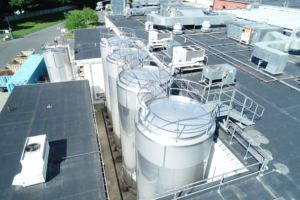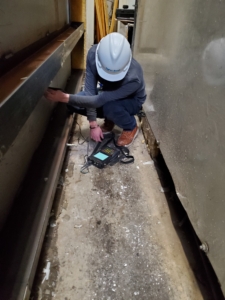Aboveground Storage Tanks: Finding Flaws Before They Find You
Aboveground storage tanks (ASTs) offer businesses a way to safely store large amounts of liquids, such as petroleum. Along with the benefit this offers owner/operators, comes the significant responsibility of maintaining these tanks.
Owners of aboveground storage tanks are required to conduct monthly and/or annual inspections, as well as periodic formal external and internal inspections. Formal inspections require API 653 or STI SP001 certification. Routine inspections by certified professionals can help identify signs of corrosion, leaks, structural issues, or potential hazards.
How We Meet Our Clients’ AST Inspection Needs

Using drone technology to perform an external inspection at the Coca-Cola plant in Northampton, MA.
To ensure their proper operation, compliance, and safety, businesses need a proactive approach. The Tighe & Bond regulatory compliance team assists our clients by providing formal AST assessments, ensuring regulatory compliance, and drafting individualized safety plans to help with system maintenance. Our team includes Steel Tank Institute (STI) and American Petroleum Institute (API) certified inspectors.
We also draft Spill Prevention, Control and Countermeasure (SPCC) plans that contain a detailed inventory of oils contained in tanks, as well as specific protocols for the prevention and management of spills. Much of the responsibility of maintaining an AST falls on the owner/operator, and our SPCC plans help to resolve uncertainties, streamline the process of maintenance, and identify spill reporting requirements.
Tools & Technologies
Our inspectors use non-destructive techniques (NDT) in external and internal inspections to ensure that tanks are safely inspected for flaws. To perform external inspections, our staff harness the power of drone technology. Using drones allows us to inspect ASTs efficiently and safely, while identifying operational conditions.
Ultrasonic Testing (UT) allows inspectors to determine the thickness of the tank material, as well as corrosion rates. Using the same principle as naval sonar, ultra-high-frequency sound is introduced into the part being inspected. If the sound hits a material with a different density than expected, some of the sound will reflect back to the sending unit and can be presented on a visual display.
Liquid Penetrant Testing (PT) involves the use of cleaner, penetrant, and developer materials to find surface flaws within a tank and make them visible. After the surface has been cleaned, penetrant solution is applied. After 15 minutes, the surface is cleaned and developer is sprayed, which will expand any remaining penetrant that is present in flaws. This process is inexpensive and can be done with portable, widely available materials.
A Focus on Safety and Reliability
Safety and reliability are two of our core values at Tighe & Bond. We put these values into action by helping our clients plan, design, and maintain their facilities; and by making sure that relevant safety and regulatory requirements are in place.

Using ultrasonic testing (UT) at an AST evaluation for Yankee Candle.
Case Study: Yankee Candle, Deerfield, MA
For over a decade, Tighe & Bond has provided AST inspection services to Yankee Candle to facilitate maintenance of their paraffin wax tanks. Our inspectors have provided formal (external) inspections, as well as periodic inspections to ensure that flaws within the tanks are identified immediately.
Back in 2021, our team was engaged by Yankee Candle to conduct an evaluation of one of their existing storage tanks to determine the viability for storage of an alternative product. Using UT, our team determined that the tank had no measurable loss of metal. However, operational concerns were identified, which needed to be addressed for the tank to hold the alternative product. Our team determined that once those operational controls were incorporated, the tank would be suitable for the storage of additional product.


